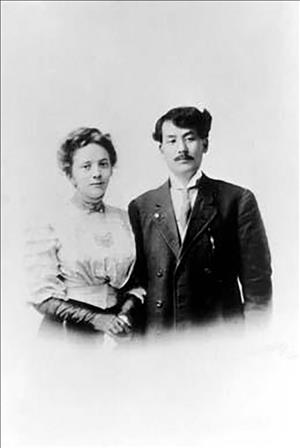On March 27, 1909, Gunjiro Aoki (b. 1883) weds Helen Gladys Emery (b. 1888) in Seattle after traveling from California and Oregon, which prohibit mixed-race marriages. The bride is accompanied by her father, Archdeacon of the Episcopal Diocese of California John Emery, and by her mother. The newlyweds plan to settle on a ranch near Seattle because of the hostility to their union in California.
Aoki, a native of Japan, was a servant in the Emery home in Corte Madera, California. When Gladys Emery announced her love for Aoki, her parents opposed the marriage. The couple was refused a marriage license in California because state law prohibited marriage between Japanese and Caucasian persons. They took a train to Portland, Oregon, where authorities refused to issue them a license on the same grounds. By this time, Gladys's parents had accepted her decision. They all planned to travel through Seattle to Victoria, British Columbia, where they could have the wedding.
The group arrived in Seattle on March 26, but quickly changed their plans. The groom and the bride's father obtained a license at the King County Courthouse. The ceremony was performed by the Rev. Herbert Henry Gowan of the Trinity Parish Church in Seattle.
Pioneers of Multiculturalism
On June 20, 1909, The Seattle Sunday Times ran an article in its magazine section titled, "How American Women And Japanese Husbands Live in Lake Washington Colony: Settlement at Bellevue a Practical Experiment in Mingling of Oriental and Occidental Races." The article states (in the racist tone common to the era):
"At the little settlement of Bellevue in the backgrounds of which this embryonic colony clusters, it is understood by white neighbors who draw the color line, that the Japanese of Seattle who favor intermarriage fondly hope at no far distant day to build up a mixed blood settlement of perhaps thousands with the idea of demonstrating to the world in the most striking fashion possible that the two races are really equal."This idea undoubtedly received a strong impetus in the Emery-Aoki nuptials. Many Japanese school boys in Seattle who find their white classmates of the opposite sex more to their liking intellectually and otherwise than their own countrywomen, have since bestowed more liberal attentions upon their fair skinned charmers."
In July 1909, Helen Aoki gave birth to a daughter, the first of their five children.

